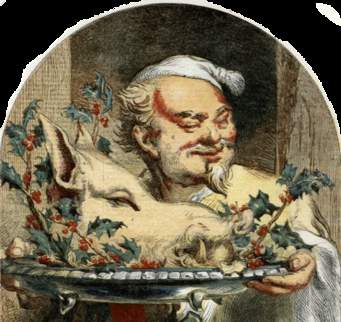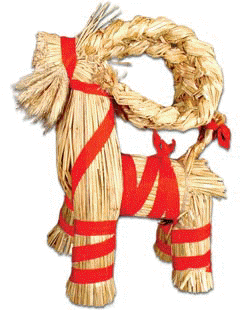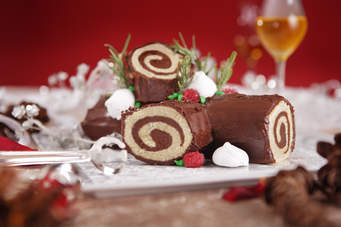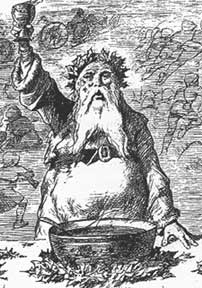Christmas and Yule are blended now but they are not the same thing.
by Gael Stirler

The boar's head was served |
Yule comes from the old Norse jól and Old English géohol which was a season of hunting after the harvest was done. This fell in what we now call December so it eventually became associated with the Christmas Holiday. The first recorded use of the noun Yuletide, according to Wikipedia, was in 1475. The Yuletide season lasted from the end of November to the beginning weeks of January but the feast of Yule lasted three days over the Winter Solstice and marked the beginning of the new year.
Yule was similar to Passover in Jerusalem before the Temple was destroyed. For Passover, the Jewish people would bring lambs, birds, and other animals for sacrifice. The blood would be offered on the altar and the meat cooked for the Passover meal. According to Norse historian and saga translator Lee M. Hollander every nine years Germanic (Norse) farmers were compelled to come to the temple hof and make sacrifices and feasts over a prescribed period of time during yuletide. Yule was celebrated in Germanic countries with animal sacrifices where the sanctified blood was then used to paint the altar, temple posts, and the supplicant himself as part of the ritual. He was literally "washed in the blood". This was followed by feasts, storytelling and drinking around a large communal fire. In Grettis Saga Yule is described as a time of "greatest mirth and joy among men."
This was also a time of oath-making. Business deals and marriages were brokered. The godi (priest, judge, chieftan) who was in charge of the hof wore a great gold ring around his neck. The people who would swear an oath, laid their hands on this ring and made their pledge in front of witnesses. Just such a ring was found at an excavation of an 11th century chieftain's residence on the outskirts of Tissø, Denmark
The most famous hof was uncovered at Uppsala, Sweden. The same temple is mention in the Heimskringla, by Snorri Sturluson and in Adam of Bremen's 11th century travel journal. It is described as housing three statues on three thrones, one for Thor, one for Wodan(Odin) and one for Fricco(Freyr). There was a great gold chain around the building, draping from the gables that flashed in the sunlight from afar. Other traveler's accounts also mention this chain. In the Ynglinga Saga by Snorri Sturluson, Uppsala was the site where King Domalde was sacrificed in the Autumn after three years of famine, for the sake of his people, and prosperity returned. The first day of Yule falls on the last day of Autumn.
In the Saga of Hákon the Good, Haakon I of Norway changed the date of Yule from the days surrounding Midwinter to the date that Christmas was observed in the rest of Europe. Though the sacrifices and religious practices of Yule were abandoned, many Yuletide customs continued.
|
|
Yule Log
Eventually many Yule customs were absorbed into Christmas celebrations as Christianity overtook Northern Europe. The oldest was the tradition of the Yule log which echoed with sacrificial significance. Originally it was a whole tree or a large tree trunk that was carefully chosen, felled and hauled to the long house with great ceremony. Then the end of the trunk was laid on the hearth and lit with a brand from the previous year's yule fire as the rest of the tree stuck out of the hearth into the room. The tree trunk was pushed into the hearth as it burned, which it did continuously for 12 days from Christmas Eve to Epiphany. At the end, the unburned part of the tree was extinguished and saved to start the fire next year. In Holland, they believed that storing the leftovers of the Yule log under a bed would protect the home from lightning strikes. No doubt a nod to Thor.
The Bûche de Noël is a French tradition that celebrates the Yule Log in the form of a fancy dessert made of thin sheets of sponge cake spread with buttercream frosting then rolled to form a log. The Bûche de Noël is then decorated with chocolate frosting bark, candy holly leaves, and meringue mushrooms.

The gift-bringer was |
The Yule Goat
Thor was said to have a chariot that was pulled across the sky by two goat bucks. During Yule they would either bring gifts to well behaved children or demand gifts on behalf of Thor. Over time the julbock became jultomte who was a combination Yule Goat/Santa Claus/Father Christmas who would bring gifts and drive a sleigh pulled by reindeer, not goats.
The Yule Ham
Just as the goat was associated with Thor, the boar was associated with Freyr. Pigs and wild boar were sacrificed to Freyr to grant a bountiful harvest or to bless marriages and children. After the sacrifices were made during a Norse Yule, the meat was boiled and eaten at the feast. In the middle ages, the boar's head was considered the best part and it was served to the head table with an apple in its mouth. Today the vestiges of this tradition are found in the Christmas Ham and the Boar's Head Carol.
Wassail translates as "Good Health" as in "I drink to your good health", but it was also the alcohol punch made with spices and fruit juice that was used to make the toast. The word toast comes from the toasted bread served with the brew. If it also contained eggs, milk or cream it was called nog. To go a-wassailing was like trick-or-treat for grown-ups. They would go from house to house and beg for wassail and other treats, like figgy pudding. The tradition originated before Christianity as an orchard blessing ritual. The people believed that the fruit trees went into hibernation when the nights grew longer. So they would gather in the orchards after Mid-winter and make as much noise as they could to wake up the trees.
|
|
Let every man take off his hat
And shout out to th'old apple tree
Old apple tree we wassail thee
And hoping thou will bear.
Over time it became an excuse for drunken revellers to wander the streets singing loudly. The modern tradition of caroling for hot chocolate and eggnog is all that remains of this old Yuletide tradition. Here is a good traditional recipe for Wassail from the Nourished Kitchen.
Mistletoe
Mistletoe was greatly revered by the Ancient Druids and the Norse people believed it was magical. It stayed green all year round even though the host tree would drop its leaves and look dead. It drew in nutrients without any roots in the earth. It was always found high up in oak and apple trees. If found in a sacred oak tree, it was cut down with a gold sickle during a special ceremony and caught in a white cloak before it hit the ground. Then the magical mistletoe was divided and a piece was given to every home in the village to ward off evil for the next year. Thus hanging mistletoe over the door became a New Year's tradition. According to About.com kissing under the mistletoe is related to Frigga also known as Freyr
The Norse goddess of love was Frigga. Frigga had two sons, one of which was blind. The evil figure of Loki made an arrow out of mistletoe wood and shot Frigga's blind son with the mistletoe arrow. The blind son died, and the goddess' tears became the mistletoe's white berries.
When Frigga's blind son came back to life later, the Nordic goddess decided to turn mistletoes in Scandinavia into a symbol of love and fertility, requiring a kiss between humans meeting beneath the mistletoe.
Sources:
- Wikipediea: Yule
- Scandinavia Travel
- Wassailling through History: Colonial Williamsburg.
- The Nourished Kitchen.
|
If you want to add this article to your list of favorites or email it to a friend, please use this permanent URL, https://stores.renstore.com/-strse-template/1311A/Page.bok. Permission is granted by the author to quote from this page or use it in handouts as long as you include a link back to Renstore.com. |
|
| Next Article |
|


